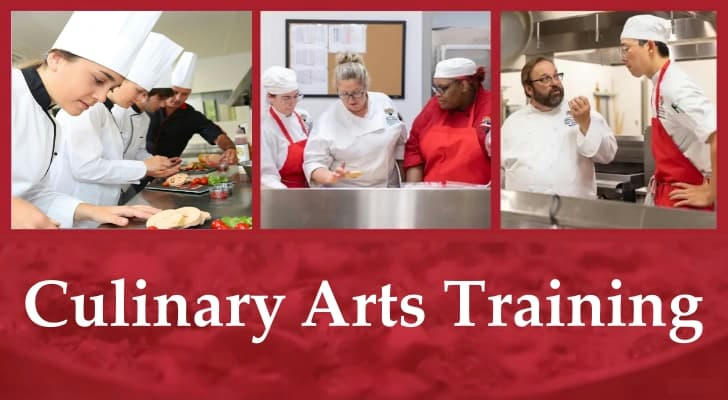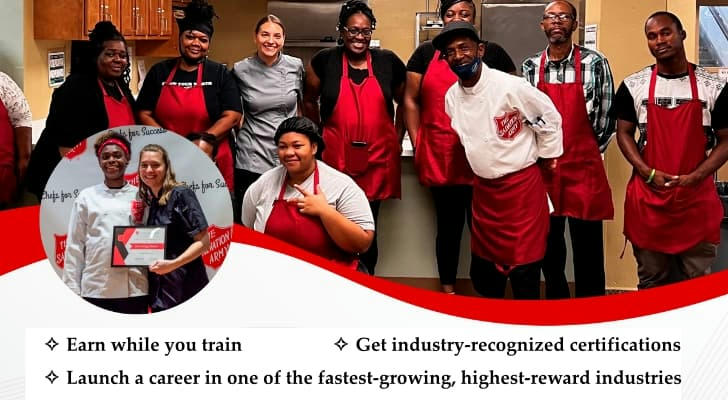🥣 Apply for Paid Culinary Arts Training – Get Certified and Start Your Cooking Career in Just 5-16 Weeks
📅 Course duration: 5-16 weeks | Government-Supported | No Experience Needed
Looking to start a career in the kitchen? Government-supported culinary arts training programs across the United States offer short-term, paid learning opportunities. Participants can earn industry-recognized certifications in 5–16 weeks and explore local culinary certificate courses to quickly enter the restaurant, hotel, catering, or food production industries.

🎓 Overview of Government-Supported Paid Culinary Training
These programs typically run 5–16 weeks and combine:
• Classroom Instruction: Food safety, nutrition, and kitchen management basics
• Hands-On Practice: Knife skills, cooking techniques, and professional kitchen operations
• Industry Certification: ServSafe or other recognized credentials
• Paid Internships or Stipends: Earn while learning, supporting living expenses
Training Benefits:
✅ Low Entry Requirements – No prior culinary or academic background needed
💰 Earn While You Learn – Receive wages or stipends during training
⚡ Fast Certification – Certificates can be earned in just a few weeks
🔪 Job-Ready Skills – Master essential kitchen techniques and professional skills
🤝 Career Support – Includes internships, job placements, and career guidance
⏰ Flexible Scheduling – Many programs offer evening, weekend, or hybrid formats
Learn more about nearby culinary programs for practical training opportunities.

👩🍳 Who Can Apply?
• Young Adults (18–24) – Quickly enter a high-demand career
• Career Changers (25–45) – Transition into stable, rewarding work
• Middle-Aged Adults (46–65) – Access secure positions with growth potential
• Older Adults (65+) – Explore flexible or part-time roles while staying active
Applicants of all ages can refer to local culinary certificate programs to find suitable training options.
📚 Culinary Certificate Programs Across the U.S.
If you are looking for local or regional culinary certificate programs, here are examples across the U.S., suitable for learners with different backgrounds and experience levels:
California💎💎💎💎💎
• Los Angeles Trade-Technical College (LATTC)
Offers courses in culinary arts, baking, and restaurant management
Accredited by the American Culinary Federation (ACF)
New York💎💎💎💎💎
• Culinary Arts Program, LaGuardia Community College
Short-term foundational culinary training and certification
Provides hands-on experience suitable for working learners
• Hot Bread Kitchen Culinary Training
A 5-week short-term program with a $200 stipend for the first four weeks
Designed for adults facing employment barriers, combined with life skills training
The average starting salary upon completion of the program is $18.38 per hour.
Florida💎💎💎💎💎
• Second Harvest Culinary Training Program
16-week training combining professional and life skills
Provides job placement and career support
These programs demonstrate that government or nonprofit-supported culinary certificate courses are available nationwide, helping learners quickly enter the industry and gain professional credentials.
📈 Chef Career Outlook
According to the U.S. Bureau of Labor Statistics (BLS):
• Over 24,600 new food service jobs are expected to be created annually through 2033
• Chefs and head cooks earned an average annual wage of $64,720 in 2024, with the top 10% making $96,030
• Growing opportunities exist in hospitals, schools, senior care facilities, private kitchens, and catering events
A career in culinary arts not only offers job stability but also creativity, international work opportunities, and fast career advancement.
Nearby culinary certificate courses can serve as a reference for learners.
📝 How to Apply for Government-Supported Culinary Training
Eligibility Requirements:
• 18 years or older
• High school diploma or GED
Application Process:
1️⃣ Search for local programs through state workforce boards or training directories
2️⃣ Check eligibility (age, location, etc.)
3️⃣ Submit an online application or attend an information session
4️⃣ Complete an admissions interview or onboarding orientation
Explore nearby culinary certificate courses for available training opportunities.
💬 Real Learner Stories
Jamila, 27 – Los Angeles
“I was working low-wage jobs with no direction until a community culinary program gave me paid kitchen training. Now I’m a sous chef at a vegan restaurant, and it completely changed my life.”
Carlos, 35 – Houston
“After leaving the military, I wasn’t sure what to do next. A government-backed program helped me get certified and land a job in a hospital kitchen. I now earn $28 per hour and feel proud every day.”
Learners can check local culinary certificate courses to explore training resources and career opportunities.
✨ Conclusion
Government-supported paid culinary programs allow anyone with passion and drive to enter a kitchen career. Through these programs, you can:
• Earn while you train
• Obtain industry-recognized certifications
• Quickly enter a high-demand culinary field
Culinary certificate programs are available across the U.S. for learners to explore.
🔗 Related Resources:
• Los Angeles Trade-Technical College (LATTC)
• Culinary Arts Program, LaGuardia Community College
• Hot Bread Kitchen Culinary Training
• Second Harvest Culinary Training Program
